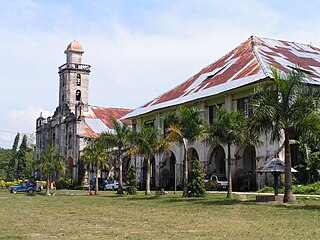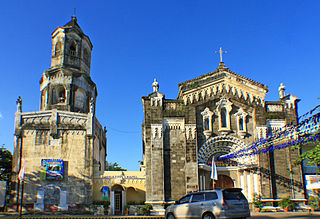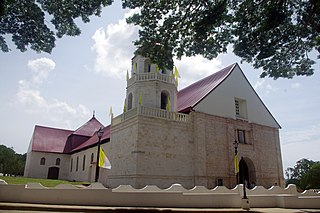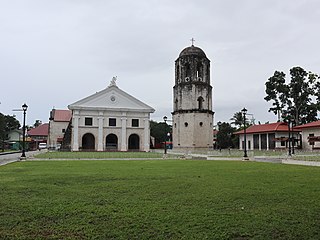
Alburquerque, officially the Municipality of Alburquerque, is a 5th class municipality in the province of Bohol, Philippines. It had a population of 11,246 people at the time of the 2020 census.

Baclayon, officially the Municipality of Baclayon, is a 4th class municipality in the province of Bohol, Philippines. According to the 2020 census, it has a population of 22,461 people.

Loboc, officially the Municipality of Loboc, is a 4th class municipality in the province of Bohol, Philippines. According to the 2020 census, it has a population of 17,418 people.

The National Historical Commission of the Philippines (NHCP) and its predecessor agencies in the Philippines and abroad installs historical markers to signify important and historic events, persons, structures, and institutions. The commemorative plaques are permanent signs installed by the NHCP in publicly visible locations on buildings, monuments, or in special locations. The NHCP also allows local municipalities and cities to install markers of figures and events of local significance, although these markers are barred from using the seal of the Republic of the Philippines.

Saints Peter and Paul Parish Church, commonly known as Calasiao Church, is a Baroque church located in Poblacion West, Calasiao, Pangasinan, Philippines. It belongs to the Vicariate of Sts. Peter and Paul under the Ecclesiastical Province of the Roman Catholic Archdiocese of Lingayen-Dagupan. The 57,840 Catholics is under the pastoral care of Rev. Fidelis B. Layog, assisted by Rev. Isidro Palinar, Jr. and Rev. Raymund Manaois.

The Archdiocesan Shrine of Our Lady of the Assumption, commonly known as the Santa Maria Church and Santa Maria Pro-cathedral, is a Roman Catholic shrine in Santa Maria, Ilocos Sur, Philippines. The church was designated as a UNESCO World Heritage Site on December 11, 1993, as part of the Baroque Churches of the Philippines, a collection of four Baroque Spanish-era churches. It is currently the pro-cathedral of the Archdiocese of Nueva Segovia while the Vigan Cathedral is undergoing repairs.

Santa Cruz Parish Church, also known as Holy Cross Parish Church and Maribojoc Church, is a Roman Catholic parish church in the municipality of Maribojoc, Bohol, Philippines, under the Diocese of Tagbilaran. The parish was first established by the Jesuits in 1767 or 1768 with Father Juan Soriano, SJ as its first parish priest. The Augustinian Recollects later administered the community until 1898.

The Fort of Saint Vincent Ferrer or commonly known as Punta Cruz Watchtower (Tagalog: Bantayan ng Punta Cruz) is a Spanish colonial era watchtower located at the western tip of the municipality of Maribojoc, Bohol, Philippines. Also known as Maribojoc Watchtower because of its geographical location, it is located three kilometers (1.9 mi) away from Maribojoc Church. It is known for being the "only perfect isosceles triangle" tower-fort structure in the Philippines.

Immaculate Conception Parish Church, also known as La Purisima Concepcion de la Virgen Maria Parish Church and Baclayon Church, is a Roman Catholic church in the municipality of Baclayon, Bohol, Philippines within the jurisdiction of the Diocese of Tagbilaran. Baclayon was founded by the Jesuit priest Juan de Torres and Gabriel Sánchez in 1596, and became the oldest Christian settlement in Bohol. It was elevated as a parish in 1717 and the present coral stone church was completed in 1727. The Augustinian Recollects succeeded the Jesuits in 1768 and heavily renovated the church since then.

San Pedro Apostol Parish Church, commonly known as Loboc Church and alternatively as the Diocesan Shrine of Our Lady of Guadalupe in Extremadura, is a Roman Catholic church in the municipality of Loboc, Bohol, Philippines, within the jurisdiction of the Diocese of Tagbilaran.

The Nuestra Señora de la Luz Parish Church, also known as Our Lady of Light Parish Church and commonly as Loon Church, is a Roman Catholic parish church in the municipality of Loon, Bohol, Philippines, under the Diocese of Tagbilaran. The parish was established by the Jesuits in 1753 and the original stone church was built from 1855 to 1864. It was declared as a National Historical Landmark by the National Historical Commission of the Philippines and a National Cultural Treasure by the National Museum of the Philippines.

The Diocesan Shrine and Parish of Nuestra Señora de la Asuncion, commonly known as Bulakan Church, is a 19th-century Neo-Byzantine-Romanesque stone church located at Brgy. San Jose, in the Municipality of Bulakan, Bulacan province, Philippines. It is one of the parishes of the Roman Catholic Diocese of Malolos under the Vicariate of the Immaculate Conception. The church was declared Marked Historical Structure of the Philippines in 2007 by the National Historical Institute, the precursor of the National Historical Commission of the Philippines. A historical marker bearing a brief history of the church was installed by the commission.

San Agustin Parish Church, commonly known as Lubao Church, is a 17th-century Neo-classic, Spanish stone and brick Roman Catholic church located at Brgy. San Nicolas 1st, Lubao, Pampanga, Philippines. It is under the jurisdiction of the Archdiocese of San Fernando. In 1952, a historical marker bearing a brief history of the structure was installed on the facade of the church by the Historical Committee of the Philippines, precursor of the National Historical Commission of the Philippines. In 2013, the church has been declared by the National Museum of the Philippines as an Important Cultural Property.

San Isidro Labrador Parish Church, commonly known as Lazi Church, is a Roman Catholic church in the municipality of Lazi, Siquijor, Philippines within the jurisdiction of the Diocese of Dumaguete. It became an independent parish in 1857 under the advocacy of Saint Isidore the Laborer.

Ludovico Deles Badoy was a Filipino politician who served as executive director of the National Historical Commission of the Philippines (NHCP) from 2002 to 2020. He previously served as the mayor of Cotabato City from 1986 to 1998.

The Diocesan Shrine and Cathedral-Parish of Saint Joseph the Worker, commonly known as Tagbilaran Cathedral, is a Roman Catholic cathedral in Tagbilaran, capital city of Bohol province, in Central Visayas, Philippines. It is the seat of the Diocese of Tagbilaran which comprises Bohol's western half. The cathedral is located in Tagbilaran poblacion and was installed with a historical marker by the NHCP in 1953.

Holy Trinity Parish Church, commonly known as Loay Church, is a Roman Catholic church located in Loay, Bohol, Philippines. It is under the jurisdiction of the Diocese of Tagbilaran.






















